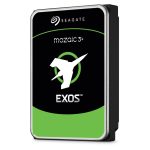Seagate has announced a significant breakthrough in the data storage industry by introducing its new Mozaic 3+ hard drive architecture. The technology includes Seagate's pioneering Heat-Assisted Magnetic Recording (HAMR) technology, enabling unprecedented areal densities of 3 TB+ per platter. However, Seagate plans to go even further, reaching 4 TB+ and 5 TB+ per platter in the coming years.
Seagate Exos series will be powered by the Mozaic 3+ technology, which will soon boast capacity points of 30 TB and more starting this quarter. However, note that these drives will only be shipped in bulk to hyperscale cloud clients, at least initially.
The Mozaic 3+ technology uses nearly the same material components as PMR (perpendicular magnetic recording) hard drives while significantly boosting capacity, enabling data centres to reduce storage acquisition and operating costs by up to 40% per terabyte of power usage. Additionally, Mozaic 3+ can help companies achieve their sustainability objectives by reducing embodied carbon per terabyte by 55% compared to a typical 16 TB PMR drive.
These advancements result from a combination of various factors. One of these is the superlattice platinum-alloy media, a new iron-platinum superlattice structure that improves disc media magnetic coercivity, which increases data writing accuracy and bit stability. Moreover, there is the Gen 7 spintronic reader, a 12nm integrated controller, and a plasmonic writer, which comprises a nanophotonic laser that generates a tiny heat spot on the medium surface to write the data reliably.
Discuss on our Facebook page HERE.
KitGuru says: Considering these 30 TB+ HDDs are just now arriving to data centre customers, when do you think the mainstream market will get similarly capable hard drives?
 KitGuru KitGuru.net – Tech News | Hardware News | Hardware Reviews | IOS | Mobile | Gaming | Graphics Cards
KitGuru KitGuru.net – Tech News | Hardware News | Hardware Reviews | IOS | Mobile | Gaming | Graphics Cards





